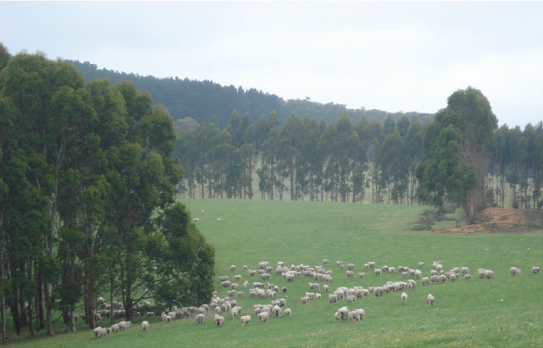The value of trees – more than carbon storage
Rachelle Meyer, Melbourne University

Integrating trees into farming systems offers environmental, productivity, and amenity benefits. The ‘Trees on Farms: maximising co-benefits’ project aims to assist farmers with decisions on tree plantings to meet multiple objectives. It is co-funded by the Department of Energy, Environment and Climate Action (DEECA) and Meat and Livestock Australia (MLA) and is part of MLA’s CN30 research program.
Planting more trees can also reduce net farm carbon emissions. With the right conditions and management, trees sequester carbon sequestration at faster rates than in soil. Tree growth and carbon sequestration varies with climate. Mixed species environmental plantings in drier areas have slower growth rates – less than 4t CO2e/ha/year, whereas fast growing species timber species in higher rainfall areas can sequester more than 30t CO2e/ha/year. Carbon sequestration generally peaks after about 10 years after planting and then slows, reaching negligible amounts about 20 years after planting.
While the contribution to reducing farm emissions wanes, shelter benefits increase over time as the trees increase heights and shelter effects extend over larger areas. Shelter benefits depends on the height and porosity of the shelterbelt. Porosity of 25 to 50% is recommended as it reduces the windspeed substantially over a larger area. The lower the porosity the more the windspeed is reduced close to the shelterbelt but the less it is reduced at intermediate distances, as dense belts create wind vortexes across the paddock. These benefits continue for the life of the shelterbelt, which may be up to 100 years.
Shelterbelts reduce wind speeds, which reduces the chill experienced by sheep. A study in the ACT found that a chill index accounted for most of the differences in lamb mortality in the first 3 days of life, particularly for multiples. Chill index varies with temperature, rain and wind speeds (Figure 1).
Therefore, trees on farms lower sheep mortality. A study in southwest Victoria found that lamb mortality in a bush paddock was 16% while it was 25% in a neighbouring unsheltered paddock. Another experiment reported mortality of 19% for singles and 27% for multiple births in unsheltered paddocks, compared with 6% for singles and 13% for multiple births. A demonstration site in southwest Victoria found a 10% increase in lamb survival in twin-bearing ewes in the paddock with more shelter. Other evidence brought together by the project indicates farmers have recorded increases in lambing rate of up to 11% and a 4.8% increase in marking rates with sheltered lambs.
Graziers in Victoria, Tasmania and NSW interviewed as part of the project all reported increases in lambing with shelter. Lambing paddocks are selected based on shelter. Trees also provides privacy and protection and improves ewe-lamb bonding.
Tree shelter can also reduce mortality in shorn sheep, but evidence is mostly anecdotal. Historic extreme chill events report mortalities of 12.2% and 11% in unsheltered shorn sheep but no losses in shorn sheep that were effectively sheltered. Others reported zero to very low mortality rates for sheltered shorn sheep.
Improvements in lamb survival will depend on the exposure of the property to cold winds and the extent to which trees reduce wind speeds. The project modelled 2 farms in Victoria, one near Hamilton and one near Bairnsdale. Lambs per ewe increased by 6.4% with a 30% lower wind speed at Hamilton while, at Bairnsdale which has lower wind speeds in winter, the increase was only 0.8% with a 15% lower wind speed. Thus, the topography and degree of exposure to wind is important for estimating the likely productivity benefit associated with shelterbelts.
NSW: ‘Shelter drastically improves the survival when lambing in bad weather. Fenced off tree lines are useful, but when lambing nice for the sheep to be in there with the trees.’
Tasmania: ‘Chill factor is a big deal here. With smaller sheltered lambing paddocks get 10% increase in survival from lambing to marking; it is especially important for twins and triplets.’
Victoria: ‘Shelter is the most important thing for any lambing ewe. A ewe in great condition with lots of food won’t save lambs from a bad weather event if there is no shelter. … For twins, …shelter and then small mobs are most important.’
Factors influencing the return on investment in trees include costs for verifying carbon outcomes (if the grazier chooses to assess or trade carbon), revenue from trees (e.g., timber) and the productivity of the pasture the trees replaced.
In our analysis, including timber revenue meant a 10% return could be achieved without assuming lamb or productivity increases. This depends on the access to timber markets. When costs of verification were low (10% of the carbon value) and the productivity of the pasture being replaced was low (< 9 DSE/ha) the odds of getting a 10% return on investment were good, ranging from 62% to over 90% depending on the extent of the wind speed reduction and the frequency of chilling.
Further Reading
- Bird, P.R. and Cayley, J 1991. Bad weather, shelter, and stock losses. Agroforestry4(4):18–19.
- Hall, Ruth. 2010. Agricultural Greenhouse Gas Emissions Audits. Report prepared for Private Forest Tasmania
- Norton, DA and Reid, N. 2013. Nature and Farming: Sustaining native biodiversity in agricultural landscapes. CSIRO publishing
- Paul, K. I., S. H. Roxburgh, J. R. England. 2022. Sequestration of carbon in commercial plantations and farm forestry. Trees, Forests, and People 9:100284
- Shea, S, et al 1998. The potential for tree crops and vegetation rehabilitation to sequester carbon in Western Australia. Carbon Sequestration Conference, Melbourne.
- Tree Alliance. 2021. The economic return on strategically planting trees on farms is obvious to this nationally recognised property. Private Forests Tasmania Factsheet - Tree Alliance.
